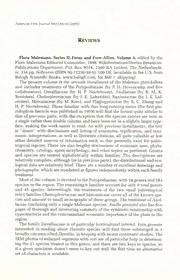
Flora Malesiana, Series II-Ferns and Fern Allies, Volume 3 PDF
Preview Flora Malesiana, Series II-Ferns and Fern Allies, Volume 3
American Fern Journal 90(l):48-50 (2000) Reviews and Volume Flora Malesiana, Series II-Ferns Fern Allies, edited by the 3, Flora Malesiana Editorial Committee. 1998. Rijksherbarium/Hortus Botanicus. RA Publications Department, P.O. Box 9514, 2300 Leiden, The Netherlands, 334 Softcover (ISBN 90-71236-39-0). 100 from iv, pp. Dfl. [available in the U.S. Balogh Books, www.balogh.com, $60 + Scientific for shipping]. The volume present the seventh installment of the Malesian pteridoflora is and Hovencamp includes treatments of the Polypodiaceae (by H. and P. five collaborators), Davalliaceae (by H. Nooteboom), Azollaceae (by R. M. K, P. Saunders), Cheiropleuriaceae (by E. Laferriere), Equisetaceae (by E. Laf- J. J. Matoniaceae M. and Zhang and erriere), (by Kato), Plagiogyriaceae (by X. C. H. Nooteboom). Those familiar with long-running P. this series (the first pte- was ridophyte fascicle published in 1959) will find the format quite similar to now that of previous parts, with the exception that the species entries are in a single rather than double column and have been set in a slightly larger type- making work As face, the easier to read. with previous installments, the text "dense" with discussions and synonyms, and is listing of typification, taxo- nomic interpretations, as well as literature citations, all quite valuable as few other detailed sources of information such as this presently exist for paleo- tropical regions. There are also lengthy discussions of economic uses, phyto- chemistry, cytology, spore morphology, and other topics as pertinent. Genera and The species are treated alphabetically within families. descriptions are relatively complete, although (as in previous parts), the distributional and eco- number logical data are relatively brief There are a of excellent drawings and which numbered photographs, are as figures independently within each family treatment. Most volume of the devoted to the Polypodiaceae, with 18 genera and 183 is The species in the region. remaining 6 families account only 9 genera for total and 45 species. Interestingly, the treatments of the two small paleotropical known families Cheiropleuriaceae and Matoniaceae cover relict of the spe- all cies and amount to small monographs of these groups. The treatment of Azol- laceae (including only a single Malesian species, Azolla pinnata] also has five pages thorough and summary of interesting of the symbiotic relationship with cyanobacteria and the concommitant economic importance of the plant in the region. The family Davalliaceae of particular horticultural Fern growers is interest. Humata interested in reading about species will find these submerged in a broadly circumscribed Davallia, in keeping with recent systematic The studies. SEM photos of enlarged segments with sori are of particular help in determin- ing the 23 species treated in this genus, and there are two keys to species, so if a given specimen doesn't seem to key out well the time an alternative first set of characters available. is REVIEWS 49 In the Polypodiaceae, another family of considerable horticultural interest North American to growers, the generic classification generally follows that of Hennipman et in the 'Tamilies and Genera of Vascular Plants" volume. An al. exception is the inclusion of Pbymatosorus in Microsorum. For this genus and Selliguea, there are secondary keys to species in different geographic subsets Malesian Malesiana some addition to the inclusion of groups of relatively great horticultural and ance seeking to understand the modern generic classification of the taxonomically complex Polypodiaceae, which, except the aforementioned very expensive for ''Families and Genera'* volume, previously has not been summarized in detail World Mis MO Bibliografia sobre Gametofitos de Helechos y Plantas Afines, 1699-1996, by Ramon Blanca Perez-Garcia and Riba. Monographs in Systematic Botany from volume the Missouri Botanical Garden, 1998. Missouri Botanical Garden 70. MO Shaw Press, 4344 Blvd., Louis, 63110. 98 Softcover [ISBN 0- St. pp. ISSN 915279-61-4, 0161-1542). $20.00 plus $4.00 shipping/handling. This useful bibliography covers nearly 300 years of publications on various The aspects of pteridophyte gametophytes. brief introduction in Spanish is and might have been printed in English as well. However, most non-Spanish speaking pteridologists will be able to understand the gist, if not the details, and of the half page that this covers, the introduction not necessary to the is The main volume use of the remaining matter. 75 pages of the contain the lengthy bibliography arranged in a single alphabetical sequence of 2195 itself, Each entry followed by one or more numerical codes in parentheses, entries. is referring to numbered headings in a subject index that follows. Similarly, a taxonomic index containing a single alphabetical sequence of genera and fam- has these numerical codes following each author/date citation. ilies A key the contents of the subject index appears on between the to p. 2, main The introduction and the text, again in Spanish. technical terms are English equivalents be usable without sufficiently similar to their as to trans- The index has two main subject headings, spores and gameto- subject lation. The Spores heading further broken into subheadings ranging phytes. five is The from factors affecting germination to ultrastructure. factors affecting ger- mination are further subdivided into eight subject areas, ranging from meth- odological concerns to environmental stimuli like temperature, light, and heading broken number chemicals. The Gametophjrtes is similarly into a of headings. As with any attempt to organize a large body of diverse subject subject headings, there are inevitable problems of literature into discrete se- The headings and overlapping subject areas in a given paper. authors lection of tendency have done creditable job of balancing the to divide the subject a
